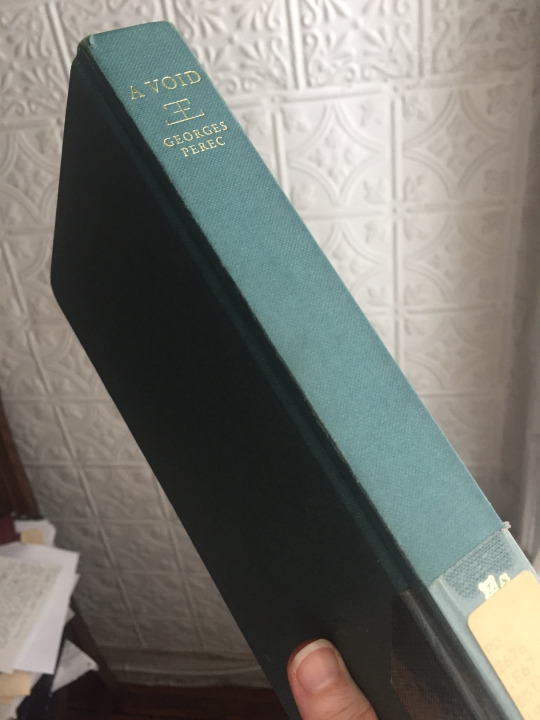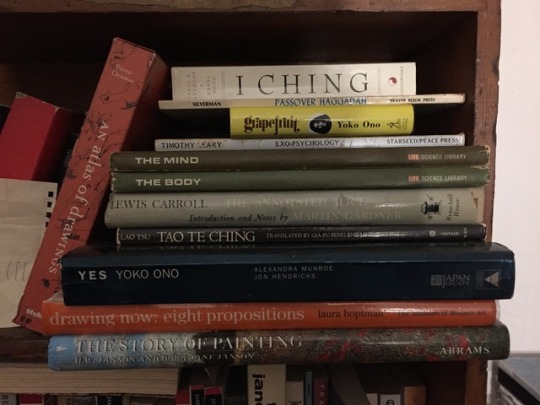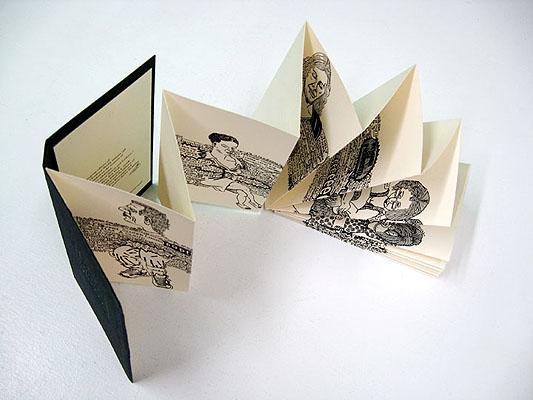Text
Good books on writing?! Here.
..and other goodies. I was recently asked if I know of any books that help people, specifically artists, write. I will include a bunch, below, plus some essays. None of them are perfect, but what is? Highly imperfect people make great writers, btw:
Stephen King’s “On Writing: A Memoir of the Craft”
Annie Lamott’s “Bird by Bird”
On the topic of editing: “Internal Revision” by Donald Murray. Link below:
https://openlab.citytech.cuny.edu/fywpd/files/2019/01/Murray-Internal-Revision.pdf
and by the same author, on revision, “The Maker’s Eye”:
https://robertnazar.files.wordpress.com/2018/09/themakerseye.pdf
Peter Elbow: “Writing Without Teachers”
Ball and Loewe, editors: “Bad Ideas About Writing” PDF free link to entire book below:
https://textbooks.lib.wvu.edu/badideas/badideasaboutwriting-book.pdf
On how to use source material in your work:
https://wac.colostate.edu/books/writingspaces2/stedman--annoying-ways.pdf
And, if you are a teacher, one of my favorite academics on the topic of reading, Ellen Carillo:
https://openlab.citytech.cuny.edu/blaineng1101regularfa2020/files/2020/08/carillo-navigating-the-storm.pdf
0 notes
Link
A sample research paper, in proper MLA format. Link above. Don’t say we never did anything for you.
0 notes
Text
Studio Visit with Our Very Own Sophia Kayafas!
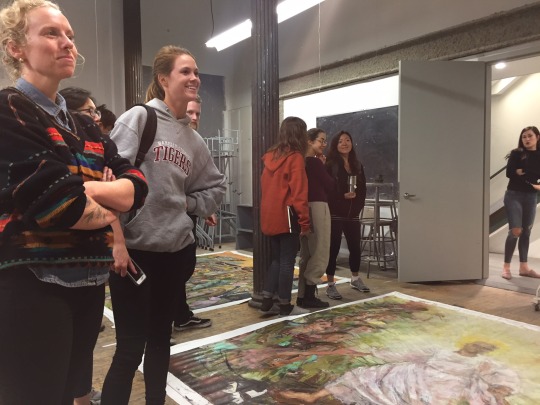
Glad to be able to sound off on her recent work before it was put away. What an amazing show. Thank you to our students for holding forth so helpfully and insightfully.

That’s our Artist!
Check out her website.
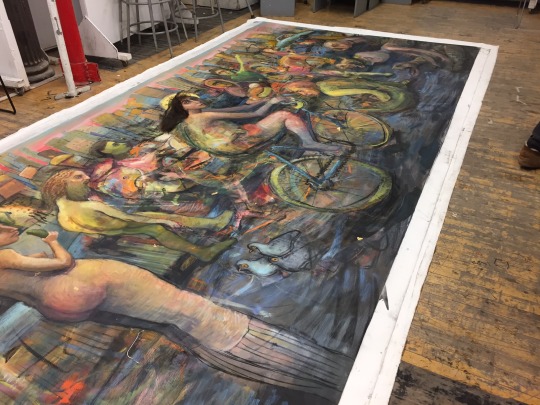
And check out her work...

...

And her bio, which she read to us:
We are all afflicted. We are a bunch of busy hurting people hoping for love. We forget that the world is full of suffering people and this makes it hard to have compassion for each other and ourselves.
My name is Sophia Kayafas, living in New York, and currently working on a new body of narratives exploring the vibrant and emotive qualities of paint. This year, an epic figurative narrative with plenty of personal religious baggage has managed to unravel itself in my studio and has left me with an abstracted kaleidoscope of concepts and experiences - in other words- a fleeting clarity.
Absurd imagery allows me to release anxieties with humor and storytelling of a grand and theatrical nature. I use confronting spiritual space evocative of Byzantine iconography in Orthodox Christian churches to discuss the age-old contradictions of the human and divine.
I explore my desperation for faith with an awareness of the absurdity of it all. Spiritual vulnerability, affliction of doubt, subconscious discovery, cultural identity, prayer, empathy, sexuality and violence coexist in a secret and sophisticated spiritual battlefield where humans, demons, angels, and saints are vividly alive.
--Sophia Kayafas
0 notes
Photo

“A Void” by Georges Perec. One of our lipogrammatic inspirations.
0 notes
Photo
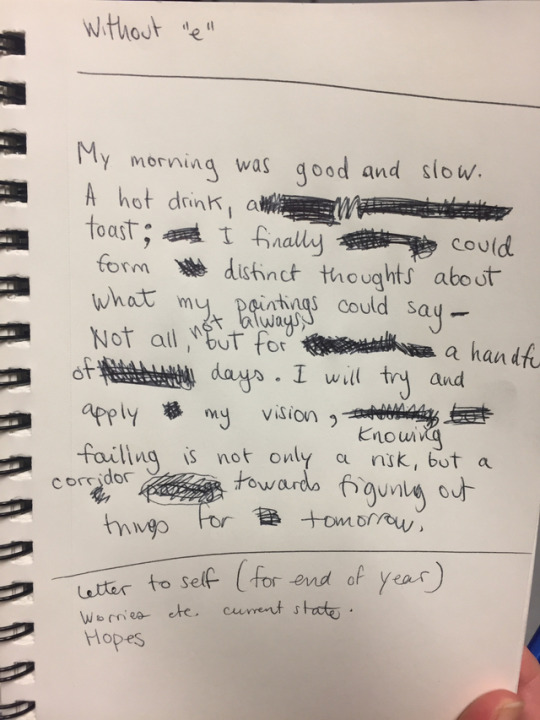
Author: Helena Valle-Dallaire. A lipogram. Sept 2017.
(First-day assignment, which Helena misinterpreted as having to be written without the letter “e” -- to good effect!
May all students misunderstand me this well.)
1 note
·
View note
Text
Our Course Syllabus 2017
Syllabus_Schmerler_Art and Culture_Fall2017_
The New York Academy of Art is a graduate school that combines intensive technical training in the fine arts with active critical discourse. We believe that rigorously trained artists are best able to realize their artistic vision. Therefore, Academy students are taught traditional methods and techniques and encouraged to use these skills to make vital contemporary art. As such, the Academy serves as a creative and intellectual center for all artists dedicated to highly-skilled, conceptually-aware figurative and representational art.
Art and Culture II – Postmodernism and Art After the Anti-Aesthetic: 1960 to Today (H602-3)
Semester: Fall 2017; Time: Tuesday 6–9PM; Room: 105 Franklin
Professor: Sarah Schmerler, e-mail [email protected] and [email protected]; Course Website: www.realtimeartists.tumblr.com
Purpose of the Course
The "Art and Culture" seminar program offers a challenging and advanced scheme of study, one which explores a range of theoretical perspectives that shape attitudes towards visual art and reflect on the human figure's enduring role. “Art and Culture II” addresses critical theory, Modernist paradigms, and the contemporary milieu. It aims to provide an academic and theoretical basis upon which to discuss current artistic practice.
The goals here are manifold, including reacting to the ideas of current artists, writers and critics, and theorists; exploring the methods and theory of art history; learning to underpin personal reactions with established scholarly approaches; engaging in reasoned discussion and debate with peers and colleagues.
In addition to a core reading list, criticism, selected writings, current newspaper articles, videos and podcasts pertaining directly to that week’s lecture may be assigned. Short, written responses to these readings are part of this course’s requirements. Some written responses will be completed during class time. If students need additional writing support, it is recommended that they purchase the following self-directed writing text: "Writing Without Teachers," by Peter Elbow. Oxford University Press 1973/1998.
All standard readings will be made available in the library for the convenience of the student. Many are available Online in the Online Course Reserves under Art&Culture II. There will be a new folder each week with readings marked for this class.
The seminar is envisioned as a forum for lively debate based on shared knowledge. It is thus crucial to attend the lectures and be prepared for class by completing the readings and written assignments each week. Active participation by all students is both encouraged and required by this instructor. Discussion will always revolve around the readings and the previous week’s lecture.
Learning Outcomes
It is expected the students will explore conceptually and creatively the ways in which contemporary artistic practice and critical theory interrelate. The student should leave with an expanded 'knowledge of contemporary artistic developments as well as a deeper understanding of the interdisciplinary nature of academic discourses on visual art. They should be further prepared to engage in studio practice within a broader context that allows them to fully engage in an ongoing cultural discourse. Students
will be given actionable reading and writing strategies that can be applied to future written assignments across their study, and will know how to apply this knowledge in context.
Course Requirements
Students are expected to attend all classes and lectures, arrive on time, and arrive prepared.
The readings will be done as homework; class time will be given over to discussion, presentations (oral, PowerPoint, and studio presentations) and work-shopped, “real-time” writing exercise. Class participation is active and lively: Over the course of the semester, students will be empowered by the Instructor in actionable techniques of art writing and verbal articulation (“lab” sessions); these may include perception-into-writing exercises. (Think of a “lab” almost like a life-drawing class in which, instead of drawing forms, we write ideas.) Students are expected to complete in-class writing exercises as assigned, and to respond in a way that is thoughtful and respectful of their fellow student, observing Class Writing Rules, the first of which is: “We affirm that our classroom is a safe space in which we can share our thoughts and feelings; we always critique our colleagues’ written work and opinions constructively and respectfully.”
It is expected that students will have read any course materials carefully and critically, that they will have absorbed the readings to the degree that they are prepared to actively participate in rigorous analysis. You may need to read articles several times through. Do not expect to do well if you gloss over the materials the day of class!
Students will be expected to discuss the course material from a broad point of view as well as their personal perspectives and opinions on the subject at hand.
In addition to lecture and seminar attendance and participation, the following assignments are required:
1. A Semester I Thesis Paper is a requirement of this seminar course. (This Thesis Paper will be further developed by each student along with their Thesis Advisor, augmented and revised as needed, and graded as a component of the MFA Thesis II in the Spring Semester.)* This first iteration of the student’s written Thesis Paper is both a self-contained document and a working draft of the final Spring Semester Thesis. It should make a convincing argument for the developing Thesis studio project, citing sources relevant to the artist’s work in philosophy, culture, and art history; it should stand as a verbal study of, and argument for, the Thesis artwork. Each student’s individual reasoning, analysis, and perceptions inform this written endeavor in much the same way they do the student’s visual work. There is no dis-connect between word and practice.
This assignment is left very broad in its description to allow for the individual voice of the student, as well as the unique integrity of the student’s individual artistic Practice, to be heard.
There will be a mid-semester deadline and at least one class session devoted to forming and evaluating a working draft of the paper, providing direct feedback to each student. (See “Revisions and...Feedback,” below.)
-Required Format: The Semester I Thesis Paper should be a minimum of eight double-spaced pages in the MLA (Modern Language Association) style. Tutuoring in MLA Style will be available in the Library on an as-needed basis.
-Due Date: Dec. 8
2. A minimum of one Artist Statement demonstrating the student’s Conceptual and Material Studio Practice.
-Due Date: Sept 25. (Both the Artist Statement and the Thesis Paper will be graded by the ACII Instructor.)
-Revisions and Stylistic and Grammatical Alterations: Feedback on the student’s papers as a whole, along with suggested edits as to tone and style and suggestions for the final spring semester will be discussed in one-on-one session with Instructor. A single day (or days, depending on class size) will be set aside for these timed conferences; students may sign up for allotted times with the class TA.
*The final draft of the Thesis Paper will be due in late March of the 4th semester and graded by your advisor as a component (10%) of the MFA Thesis.
3. A 15-minute PowerPoint/Multi-Media/Spoken presentation that fuses the concerns of the student’s thesis/personal research with the practice of a single artist or artistic movement from 1960 to the Present (each student will be assigned their own subject). This Presentation topic must be approved first by Professor.
Outline
The course will be structured around the following areas and themes:
A General Overview of the issues of Art and Culture Since 1960 including...
• Phenomenology (how it is physically practiced as well as its role in art criticism); The Mechanics of Perception
What is the current state of Art Criticism and how did it get that way?
The Power of Descriptive vs. Subjective Language; How Can We Write Objectively as Artists?
Artists Making Statements after WWII:
Axiomatic Statements (Sol LeWitt) and Instruction-based Statements (Yoko Ono) and Manifestos (Mierle Laderman Ukeles and 1970s Feminist Practice)
Assemblage and Performance (Concrete Constructions vs. Temporal Happenings; Sound Art Objects); John Cage
Figuration (Including Body Art, and issues of Race, Gender, Identity, and Genetic Manipulation); Modern Dance and Plastic Arts
Site Specificity; Context-based and Context-dependent Display
Museological Display and Institutional Critique; the Role of Curator as Creator
Warburgian and Radical Contemporary Curatorial Practice.
• The Shifting Role of Photography vs. Painting
Important Dates
First Artist Statement of Material Practice Due: Sept 26
Studio Practice Conference: Completed by Oct 31
Midterm Grades Due: Oct 20
PowerPoint/Multi-Media/Oral Presentation: Completed by Nov 21 Final Research Paper Due: Dec 8
Mid-Year-Crit Rehearsal Run Through: Dec 12 Last Day of Classes: Dec. 15
GRADES DUE: Dec. 15
(Course outline subject to revision!!)
Grading Rubric
Class Participation: 25% (This includes: fulfillment of in-class, “real-time” writing assignments; constructively contributing to discussion and critique; satisfactory completion of assigned readings and written homework; general professionalism and course readiness; peer-to-peer discussion exercises.)
Written Artist Statements: 20%
PowerPoint/Oral Presentation: 15%
Outline of Thesis Paper with any applicable Bibliographic References and Influences in MLA Style: 15%
Final Draft of Semester I Thesis Paper: 25%
Mid-Year Crit Rehearsal and Run Through: S for Satisfactory; U for Unsatisfactory (no letter grade)
(Effort, trackable improvement, and the exemplary application of skills above and beyond requirements will be rewarded.
Content, Difficulty of Task, and Clarity of Presentation are considered as factors within each assigned project.
New York Academy of Art Attendance Policy (from the student handbook)
Due to the instructional rigor invested in many of its courses, the Academy has specific attendance requirements for both instructed and uninstructed sessions (studio sessions).
Instructed Sessions
Attendance at instructed sessions is mandatory. The individual instructor is responsible for taking attendance and may fail any student who has missed four or more instructed classes. Students must notify the instructor in writing if they know in advance they will be absent from a particular class, and ask the instructor to specify what course content (readings, and assignments) will be covered during their absence. Students are responsible for making up class work during all periods of absence and may request permission to perform comparable study, which may be granted according to the discretion of the instructor. Each instructor may augment the Academy’s attendance policy with additional expectations.
T ardiness
Unexcused tardiness or early departures from class will be counted as absences.
New York Academy of Art Plagiarism and Copyright Policy (from the student handbook)
The Academy holds to the highest standards of academic conduct and honesty. Plagiarism and copyright infringement will not be tolerated. Plagiarism, or the use of another’s work, words, or expressions without attribution or permission, includes paraphrasing in a form close to the original. Whether the sources being borrowed are published or unpublished, or in print or on the Internet, they must be cited. Plagiarism can result in suspension or expulsion from the Academy. Likewise, the Academy attempts to combat unauthorized distribution of copyrighted material. It is illegal to violate any of the rights provided by copyright law to the owner of the copyright, although there are limitations on these rights, including the doctrine of “fair use.” The Copyright Act of 1976 can be found at http://www.copyright.gov/. The doctrine of “fair use” is largely governed by case law. Students with questions concerning copyright and fair use can ask the Academy librarian for further direction. Downloading copyrighted material from the Internet without permission is also illegal. Students should not use the Academy’s or their personal computers to distribute copyrighted material without the permission of the copyright owner. Under certain circumstances, the Academy may be compelled to disclose violations of law by its students and faculty.
0 notes
Link
Jason Andrew is a curator who has set the bar for how to exhibit (professionally) in a domestic space.
0 notes
Video
Martin Wilner - Making History: The Case Histories 2014, Hales Gallery, London (27 March - 16 May, 2015)
#Vimeo#halesgallery#hales#martinwilner#wilner#london#contemporaryart#drawing#eastend#shoreditch#psychoanalysis#makinghistory#casestudies#casestudy
0 notes
Text
John Cage Drawing by Ting-Ting
Amazing work; it is now our official “avatar.” The flowing lines were in response to the room’s shape, and the configuration of bodies therein; the “dots” were created in response to the moments of silence in between the Movements of John Cage’s 4″33 which was played in class on October 17, 2016.

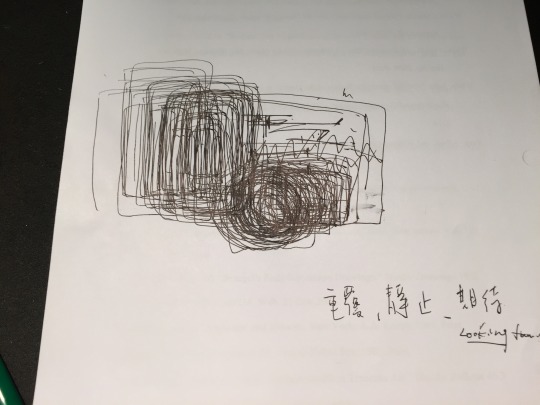
0 notes
Link
Enjoyed this from artist McNair Evans’ blog.
There are lots of lists out there.

0 notes
Video
youtube
This is the poetry slam we watched in class by three young ladies of Get Lit. It was aired on the Queen Latifah Show.
FACT!
1 note
·
View note
Link
Hi Class. In this clip Laderman-Ukeles briefly explains her exhibition “Washing” which took place in Soho in 1974. Note how she uses words like “normalized” and “resume” to create a finite temporal space in which she CLAIMS her artistic intention. She DECLARES this is a physical and temporal space in which her work is artwork. Bam!
0 notes

